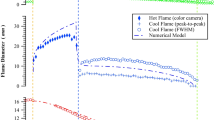Abstract
The combustion behavior of a methane hydrate sphere under normal gravity is experimentally investigated. The initial diameter of the sphere is 20 mm. Variation in temperature at the center of the sphere (T c) is measured with a K-type thermocouple at ignition temperatures (T c,i) from 193 to 253 K at 20 K intervals. Variation in the near-surface temperature of the sphere (T s) is measured at ignition temperatures (T s,i) from 233 to 263 K at 10 K intervals. Two combustion phases are observed. When the hydrate is ignited, a stable flame envelope is formed around the sphere (phase 1). In phase 1, the surface of the sphere is dry. After a few seconds, water formed by dissociation of the methane hydrate appears on the surface and methane bubbles are formed by methane ejected from inside the sphere (phase 2), thus destabilizing the flame and causing local extinction. Methane bubbles move down along the surface and merge into a large methane bubble at the bottom of the sphere. This bubble bursts, releasing methane to form a temporary flame, and the water drops from the hydrate sphere. Water on the surface is cooled by the hydrate inside, and an ice shell confines the methane gas that dissociated inside the sphere. Because the dissociation occurs continuously inside the hydrate, the inner pressure gradually increases and at some instant, the ice cracks and methane gas is ejected from the cracks, which results in a micro-explosion with a flame. In phase 1, the surface temperature is below the freezing point of water, and so the surface remains dry and a stable flame envelope is formed; in phase 2, the surface temperature is above the freezing point, and so water appears on the surface. When the temperature at the center of the sphere is lower (193, 213, or 233 K), some methane hydrate remains even after flame extinction because heat transfer from the flame decreases in phase 2 as a result of local extinction. The diameter of the sphere decreases during combustion in accordance with the d-square law, which indicates that the heat of dissociation is supplied by the flame and methane is supplied by the dissociation of methane hydrate in the sphere, as in single-droplet combustion.















Similar content being viewed by others
References
Chen X, Li X, Chen Z, Zhang Y, Yan K, Lv Q (2015) Experimental investigation into the combustion characteristics of propane hydrate in porous media. Energies 8:1242–1255
Godsave GA (1953) Burning of fuel droplets. Proc Combust Inst 4:818–830
Gudmundsson JS, Borrehaug A (1996) Frozen hydrate for transport of natural gas. In: Proceedings of the 2nd International Conference on Gas Hydrates. 415–422
Iwata M, Ueda T (2002) In: Proceedings of the 4th International Conference on Gas Hydrates. 1059–1062
Javanmardi J, Nasrifar K, Najibi SH, Moshfeghian M (2005) Economic evaluation of natural gas hydrate as an alternative for natural gas transportation. Appl Therm Eng 25:1708–1723
Kaneko H, Okui T, Kagami H (1997) The combustion of methane hydrate. In: Proceedings of the 35th Symposium (Japanese) on Combustion. 462–464
Kim NJ, Kim CB (2004) Study on gas hydrates for the solid transportation of natural gas. KSME Int J 18(4):699–708
Kitamura Y, Nakajo K, Ueda T (2002) Numerical calculation of a diffusion flame formed in the laminar boundary layer over methane-hydrate. In: Proceedings of the 4th International Conference on Gas Hydrate 4. 1055–1058
Klauda JB, Sandler SI (2005) Global distribution of methane hydrate in ocean sediment. Energy Fuels 19(2):459–470
Kumagai S, Isoda H (1957) Combustion of fuel droplets in a falling chamber. Proc Combust Inst 6:726–731
Kuo KK (1986) Principles of Combustion. Wiley, New York
Law CK (1982) Recent advances in droplet vaporization and combustion. Prog Energy Combust Sci 8(3):171–201
Maruyama Y, Fuse JM, Yokomori T, Ohmura R, Watanabe S, Iwasaki T, Iwabuchi W, Ueda T (2013) Experimental investigation of flame spreading over pure methane hydrate in a laminar boundary layer. Proc Combust Inst 34:2131–2138
Matsuo K, Iwasaki T, Katoh Y, Yamaki T, Takahashi S, Ohya N, Ogawa K (2005) Process development of NGH system (Part2)—demonstration of natural gas transport using NGH. Mitsui Zosen Technical Review 184: 38–45 (in Japanese)
Misyura SY (2013) Effect of heat transfer on the kinetics of methane hydrate dissociation. Chem Phys Lett 583:34–37
Misyura SY, Nakoryakov VE (2013) Nonstationary combustion of methane with gas hydrate dissociation. Energy Fuels 27(11):7089–7097
Mori YH (2003) Recent advances in hydrate-based technologies for natural gas storage—a review. J Chem Ind Eng (China) 54:1–17
Nakamura Y, Katsuki R, Yokomori T, Ohmura R, Takahashi M, Iwasaki T, Uchida K, Ueda T (2009) Combustion characteristics of methane hydrate in a laminar boundary layer. Energy Fuels 23:1445–1449
Nakoryakov VE, Misyura SY (2013) The features of self-preservation for hydrate systems with methane. Chem Eng Sci 104:1–9
Nakoryakov VE, Misyura SY, Elistratov SL, Manakov AY, Sizikov AA (2013) Methane combustion in hydrate systems: water–methane and water–methane–isopropanol. J Eng Thermophys 22:169–173
Spalding DB (1953) The combustion of liquid fuels. Proc Combust Inst 4:847–864
Stern LA, Circone S, Kirby SH, Durham WB (2001) Anomalous preservation of pure methane hydrate at 1 atm. J Phys Chem B 105:1756–1762
Takahashi F, Heilweil IJ, Dryer FL (1989) Disruptive burning mechanism of free slurry droplets. Combust Sci Technol 65(1–3):151–165
Takahashi F, Dryer FL, Williams FA (1998) Combustion behavior of free boron slurry droplets. Proc Combust Inst 21(1):1983–1991
Williams A (1973) Combustion of droplets of liquid fuels: a review. Combust Flame 21(1):1–31
Williams FA (1985) Combustion Theory. Benjamin/Cummimgs, Menlo Park, California
Yoshioka T, Suemitsu M, Yokomori T, Ohmura R, Ueda T (2015) Flame propagation over a methane hydrate with surface temperature variation in a natural convective flow field. Mech Eng Lett 1:15–00370
Author information
Authors and Affiliations
Corresponding author
Rights and permissions
About this article
Cite this article
Yoshioka, T., Yamamoto, Y., Yokomori, T. et al. Experimental study on combustion of a methane hydrate sphere. Exp Fluids 56, 192 (2015). https://doi.org/10.1007/s00348-015-2041-4
Received:
Revised:
Accepted:
Published:
DOI: https://doi.org/10.1007/s00348-015-2041-4




